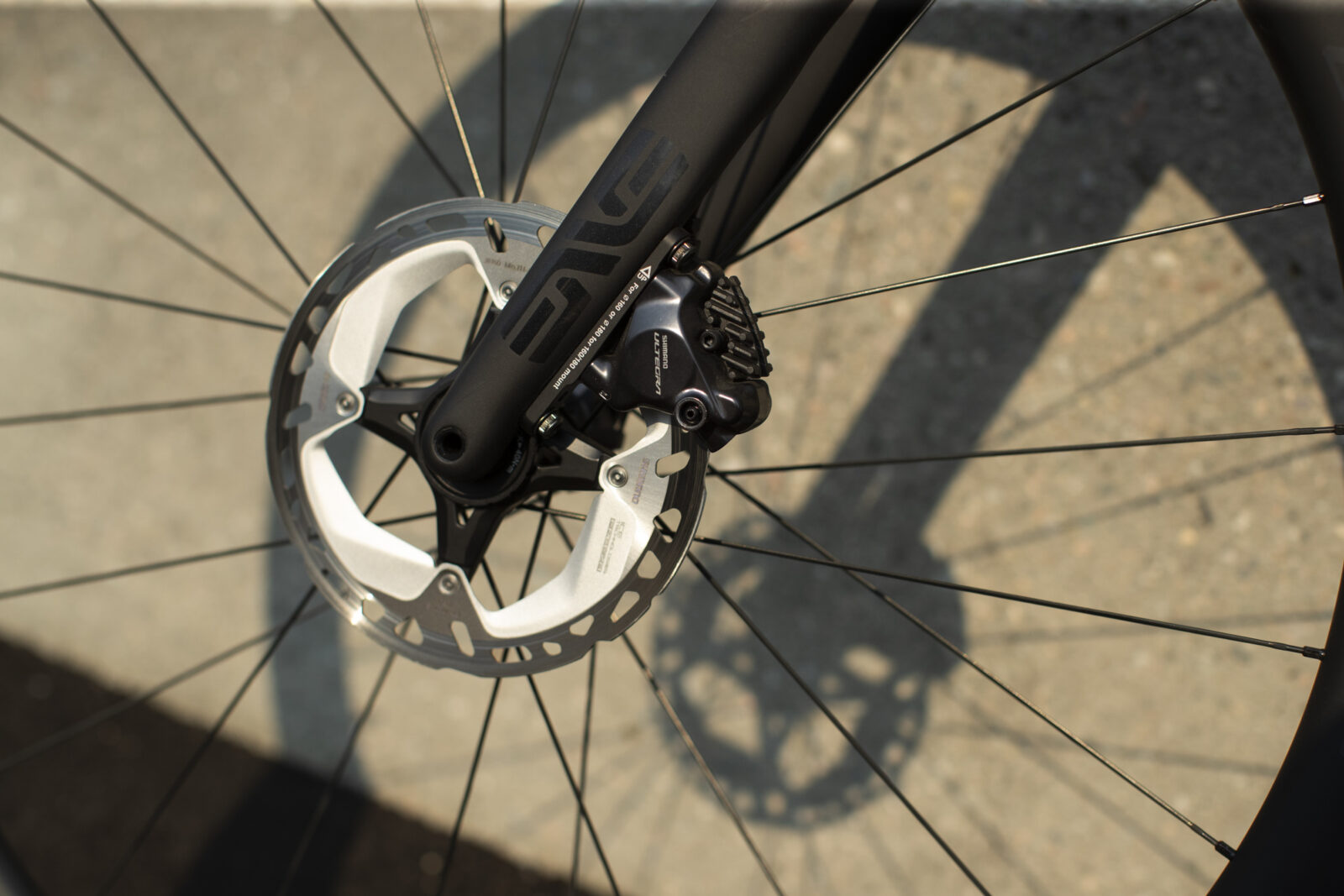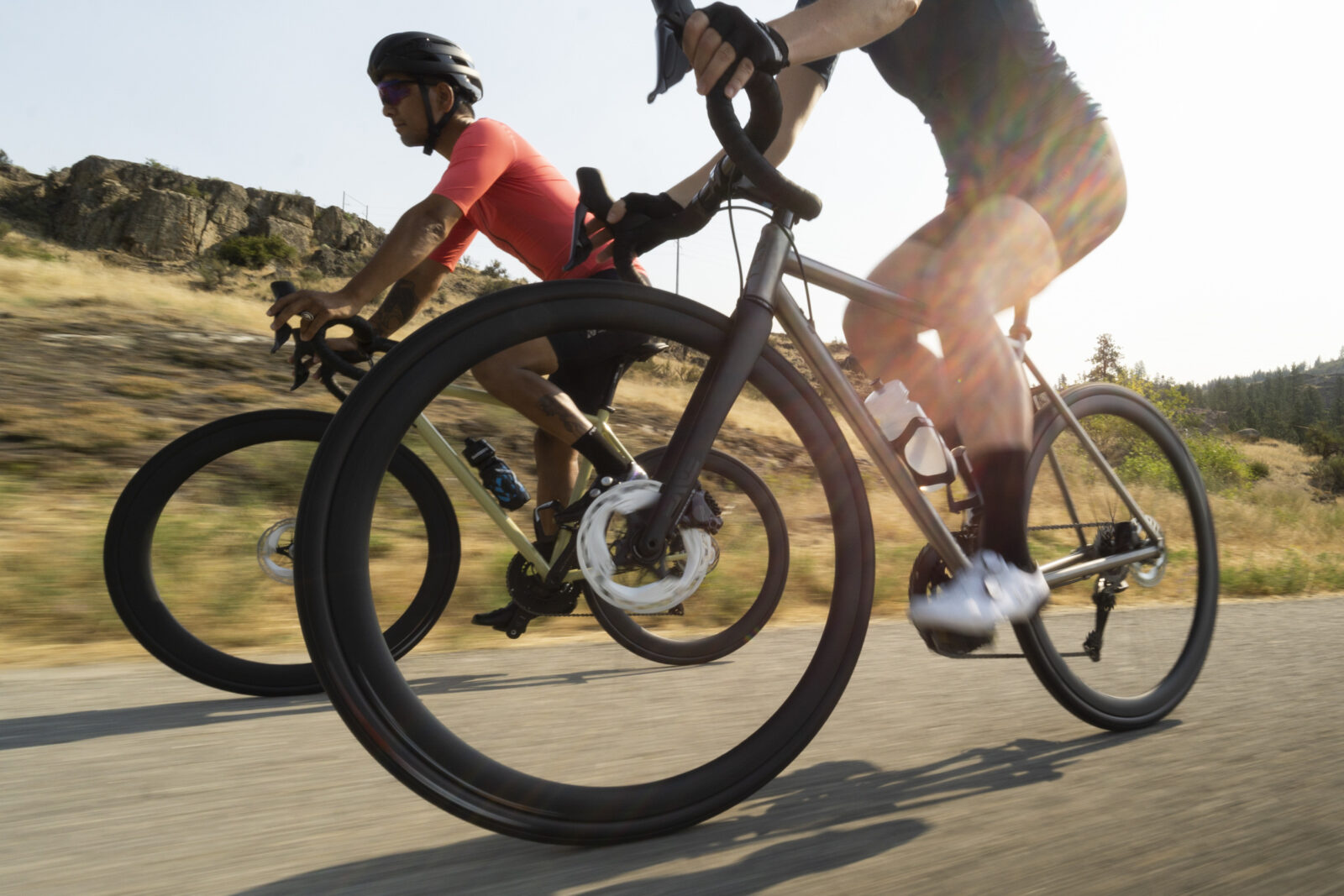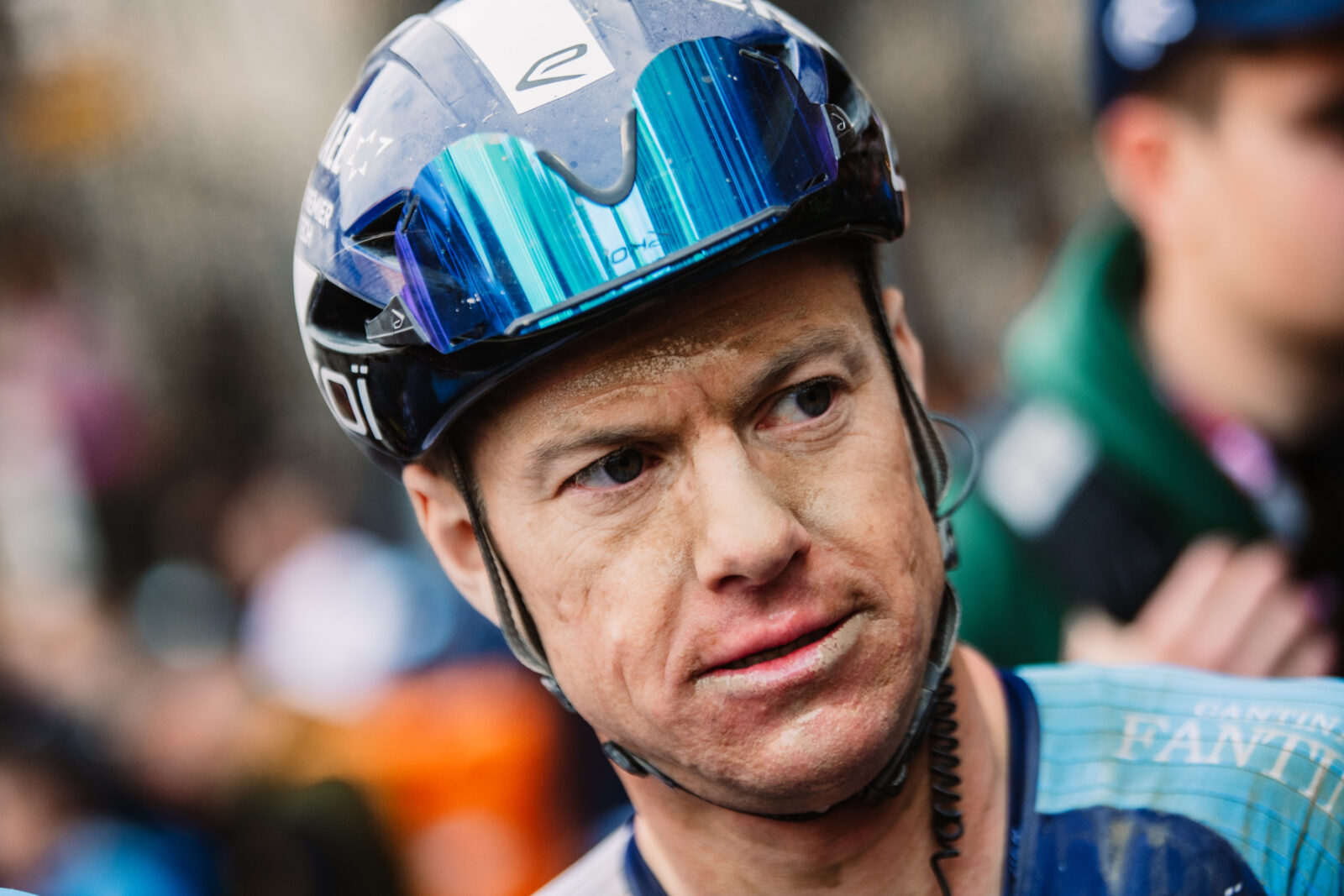Most road bikes now come with disc brakes, so we thought it was timely to ask a few experts and solicit their opinions on whether riders should consider upgrading.
Cervélo no longer offers road bikes with rim brakes and introduced its last rim brake bike in 2018 alongside its disc brake counterpart.
Over the past decade, road bike brakes have transitioned from rim brakes to disc brakes, with the latter now almost completely dominating current bike offerings. There are a few rim brake models still available on the market, but you have to hunt around.
To gather a variety of views, we spoke with Shimano, the leading component manufacturer. We also sought the views of two leading bike manufacturers, Cervélo and Trek. We rounded this out with a chat with a pro team Equipment Manager and veteran rider of Israel-Premier Tech.
Disc brakes are not new. They were first introduced in the 1970s when they were used on cars and motorbikes. This was followed by disc brakes on mountain bikes in the late 1990s. It wasn’t until the mid-2010s that they were first fitted to road bikes.

The Union Cycliste Internationale (UCI) is the governing body of cycling and is responsible for creating and enforcing regulations for equipment, among other roles. In 2015 and 2016, they tested the use of disc brakes and declaring their tests a success, made them legal across the sport from 2017.
As a consequence, most teams began using disc brakes, and in 2022, rim brakes disappeared from WorldTour road bikes. However, several teams still used time trial bikes with rim brakes until this year, when all have moved to disc.
But what are recreational riders like you and me riding? When researching this article, we polled our Bicycling Australia Strava Club members and asked the simple question: “Does your main road bike (the one you ride most of the time) have disc brakes or rim brakes?” We received 77 responses – 41 disc and 36 rim, which is fairly close to 50/50. I think this group is fairly representative, so there are plenty of Australians still riding rim brake bikes.
The benefits of disc brakes are undisputed, including more power, better modulation, and all-weather capability.
Disc brakes, especially hydraulic disc brakes, provide substantially more stopping power than rim brakes. Modulation refers to the ‘feel’ coming through the brake system as a rider applies and releases pressure on the levers. Disc brakes offer better modulation than rim brakes.
The biggest benefit for everyday riders is the all-weather ability that disc brakes provide. Rims and calipers are hugely compromised systems when wet, while disc brakes offer very constant performance in all conditions.
What the component manufacturer says
We started by asking Shimano’s Australian Marketing Manager, Toby Shingleton, what percentage of road groupsets they now sell in disc brake, to which he responded, “It depends how you define road, but if it is 105, Ultegra and Dura Ace, then it’s 99 per cent or above in Australia.”
He also said that Shimano has no plans to discontinue supplying spare parts for road caliper brakes.
“Shimano doesn’t see any market demand for rim brakes for complete bikes moving forward and declining demand for wear-out parts as bikes are superseded. Our supply of braking technology is based on demand from our customers (bike manufacturers). As they continue to develop new bikes, we seek to meet their demand for the best products for riders,” added Shingleton.

What the bike manufacturers say
Bike manufacturers have a vested interest in encouraging riders to upgrade to a disc brake bike. We spoke to Cervélo and Trek, and while both spruiked the virtues of disc brake bikes and the other benefits that awaited riders, neither pushed hard on the need for riders to upgrade if they were still happy riding their rim brake bike.
Maria Benson, Director, Product Management at Cervélo said, “When disc brakes were first introduced, the main complaint was that they were heavy, and I still hear that today. However, this is no longer relevant because everything is getting lighter and lighter; carbon parts and drivetrains alike. So we can easily get a road bike down below UCI minimum requirements with disc brakes.”
Like many road bike manufacturers, Cervélo no longer offers road bikes with rim brakes. “We introduced our last rim brake bike in 2018 alongside its disc brake counterpart.”
Instead, their product development efforts focus on disc brakes.
“Disc brakes offer riders many benefits, including aerodynamics. We no longer have external cables (which have a huge aerodynamic penalty) because the hydraulic hose is easier to route internally. Whereas mechanical brake cables can be kinked when routed internally, which diminishes their performance.
“We now design frames around disc brakes, whereas when disc first hit the scene, we were trying to adapt rim brake designs to accept disc brakes. So, we can even pay attention to smaller details, such as the brake mounting area, to optimise the carbon to be suited for the forces of disc brakes for better handling characteristics.
“Other huge benefits riders get when they upgrade to disc brakes are performance and safety. Disc brakes are superior on long descents and in wet weather. They change the way riders ride, allowing them to corner and descend faster. You no longer need to worry about rim delamination on longer descents from holding the brakes and overheating the carbon surface.
“Riders also benefit from the extra tyre clearance because you’re not constrained by the rim brake caliper. By opening up that space, we have been able to explore wider rim and tyre combinations, which have turned out to be not only more compliant but also aerodynamically faster due to rim shape development and the interaction to the tyre,” said Benson.
“Triathlon/TT bikes could arguably be getting the most significant improvements due to disc brakes. Configurations of TT rim brakes were just never very strong and difficult to set up properly, causing riders to need to brake earlier and generally ride more gingerly. With disc brakes, Triathlon/TT bikes have the same stopping power as a drop bar bike.”

Whitney Beadle, Road & Gravel Marketing, Trek Bicycle, also confirmed that none of their current road bikes are fitted with rim brakes. “Our current generation of road bikes is all disc, but we have some lingering rim models available in some markets.”
“There are tonnes of benefits with disc brakes. These include more powerful braking that is reliable in all weather conditions. The ability to use single-finger braking. Plus, it’s easier to replace disc brake rotors and pads and more cost effective.
“The improved design that comes with disc brakes gives us the ability to run wider tyres. Even our race team is on wider tyres.”
Beadle also spoke about the aerodynamic benefits of disc brakes. “The disc brake systems also allows us to further develop the aero rim shapes, giving the wheels a more aero profile, allowing higher speeds.
“Disc brake systems are also more user-friendly for removing and refitting wheels. With thru-axles, you can’t put the wheel on crooked, which was a common problem with rim brakes.
“Internal cable routing is also much easier with disc brakes, which is why you now see most road bikes with internal cables, which makes them more aerodynamic and arguably look better, too.
“Overall, the improved frame technology means a better ride experience and the wider tyres make the ride more comfortable,” said Beadle.
“When we developed the current model Domane we looked at the front and rear tech and could isolate IsoSpeed comfort tech to the rear and pull weight from it.”
When asked about spare parts and replacement frames for Trek riders on rim brakes she said, “As for ongoing support of our rim brake bikes in the market, we offer replacement parts for all our bikes. However, all products have a life cycle, so there will be a time when no rim brake frames will be available, and in that case, we offer a replacement discount.”

What the pro team mechanic said
Gary Blem, the Equipment Manager at the Israel-Premier Tech WorldTour team, has been a bike mechanic with the pro peloton for more than 20 years. During that time, he has seen many changes in the equipment, including the introduction of disc brakes to the pro ranks.
“I was at Team Sky when disc brakes came in, and we had many teething issues. We held out as long as possible but eventually had to move across. It was a nightmare because they weren’t refined. The clearances between the rotor and pads had a minimum clearance, which caused several issues for us.
“Looking back, it was not a smooth transition because the manufacturers forced us to change. I was (Chris) Froome’s mechanic at the time of the changeover, and he struggled with it. He often contacted me when he was out on a training ride to tell me his brakes were rubbing.”
TeamSky, which is now Ineos Grenadiers, was one of the last teams to move fully to disc brakes. Gary now concedes that the disc brake groupsets have been refined, and the problems are no longer there.
“The current 12-speed groupsets are bulletproof. There is more clearance, and they now require very little maintenance.
“Building a bike for us is now more complicated, and there are no more quick wheel changes. However, the change from mechanical to electronics groupsets means they have become bulletproof.”
For average riders, Gary believes whether you need to move to disc brakes depends on where you live and ride. “In my native South Africa, we don’t have long descents like in Europe, or bad weather, so rim brakes are fine for most riders.”
“The industry is pushing the change, and rim brakes will be phased out and spares will be harder to get. But it’s a bit like software updates; you keep updating and eventually need a new one.
“The pro teams are constantly pushing manufacturers for better and better products to make marginal gains. Colnago as a brand was dying pre-UAE, but with (Tadej) Pogačar, they wanted to give him the best product. Now, he has one of the best bikes on the market, and everyday riders get to buy the same product.”
“In the pro ranks, we’ve learnt a few important lessons with disc brakes, and I’d strongly advise riders not to mix groupset manufacturers. Stick with either Shimano, SRAM or Campagnolo, but don’t mix the components.”

What the veteran pro team rider said
Simon Clarke has been a pro cyclist since 2009, when he signed his first pro contract. That means he’s lived through the transition from rim to disc brakes within the pro peloton. He currently rides for Israel-Premier Tech.
“The main benefit of disc brakes is wet weather performance. Discs provide more stopping power, although I don’t think we lacked braking power with rim brakes.
“We all struggled with the transition, and the current brakes are certainly much better than the first iteration. Shimano initially tried to make the new disc brake levers the same shape as the rim ones, which compromised performance. With the current 12-speed levers, this issue has been overcome, and they perform much better.
“With disc brakes, it’s very on/off but you get more modulation. So, it’s easier to put yourself over the handlebars because they are so powerful. There are pros and cons, but I think the positives outweigh the negatives.
“We’ve seen improvements in aerodynamics with the inclusion of disc brakes. Instead of the caliper at the top of the wheel, the disc brakes are lower. The head tube has also changed dramatically, which has improved the bikes. They have also made the rear half of the bike as light as possible to compensate for the heavier brakes.
“When they were introduced, we added 300 grams to the bike’s weight, and now it’s a constant struggle to get the weight down,” added Clarke.
During his 16-year professional cycling career, Clarke has witnessed numerous improvements and updates to road bikes.
“The manufacturers are constantly developing the frames, but I think they’ve reached a development ceiling. Without regulation change, they have reached a threshold and will continue to produce similar models.
“For the average rider, it depends on how and where they ride. For pure climbers, rim brakes are better. But disc brakes are better for heavier people and less experienced riders on descents.”

Conclusion
Disc brakes offer superior braking in wet conditions and on long descents, but rim brakes still perform well in most situations. It is, however, clear that the bike industry is phasing rim brakes out, and all new product development is centred around disc brake technology. So, if you want the latest road bike with all the benefits of many years of R&D, it might be time to consider an upgrade.
Nicola Rutzou – a long-time contributor and, most recently, the editor of Bicycling Australia. Nicola is a keen Sydney-based road cyclist who writes reviews, news, and destination pieces, as well as the weekly e-newsletter for BA online.



The difference in maintenance requirements for rim vs disc is like chalk & cheese! One less thing to have to muck around with (or pay for!). I’ll see my days out on rim brakes which give me all the stopping power I need & we live on a 12% downhill.